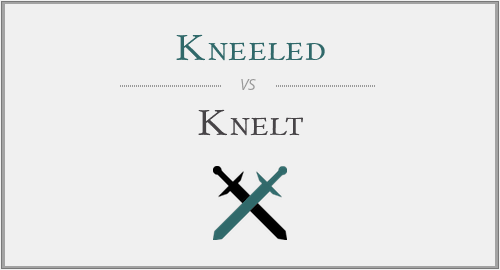If you doubt the correct form of the past tense of the verb “to kneel”, that’s a normal confusion that English users commonly experience when they see both “kneeled” and “knelt” written in several publications or articles. Is it a common misspelling, or is there any rule that you can’t spot out there requiring one or the other spelling according to the context?
It’s actually not. The pair of words “kneeled” and “knelt” applies a very similar rule as “knit” and “knitted”. It’s almost the same situation, so we also invite you to read that article in order to clear your doubts. In this article, we’ll make it clear for you with “kneeled” and “knelt”.
Kneeled vs. Knelt
Usually, English verbs split into regular and irregular verbs when it comes to the past tense. Regular verbs form simply by adding “-ed” in the end, both for past tense simple and past tense perfect. But, there are also some special situations when verbs can apply both rules, because their structure and the way they are pronounced allows this naturally. It is exactly what happens to “kneel”.
The verb defines the action of going down or sitting in a position with one or both knees on the ground. And it is a perfect example of a verb that accepts both a regular and irregular form to express the past tense. See below how.
When do we use “kneeled”?
Regular verbs form both past simple and past perfect tenses by adding “-ed” in the end. If “kneel” is considered a regular verb, it is exactly how “kneeled” is created. This spelling is a little longer, but easier to remember due to applying the most basic and classical rule in English past tense formation.
Example: The man kneeled forward and tried to catch the ball for the dog quickly. – “kneeled” a correct spelling for the past tense of “kneel”.
When do we use “knelt”?
“Knelt” is an equally correct spelling for the past tense form of the verb “kneel”, if the word is considered irregular. A lot of people prefer it because it’s shorter and faster to type. But there is no restriction to require this spelling rather than “kneeled”.
Example: Her mother knelt down next to her, to make sure she was ok before helping her get up. – “knelt” is also a correct form for the past simple and past perfect tenses.
Conclusion
You don’t have to worry or overthink the situation when you have to choose the past tense for the verb “kneel”. No matter what spelling you choose, you can’t possibly be wrong. All notorious dictionaries and English guides specify both “knelt” and “kneeled” as correct spellings for the past tense of “kneel”.





Have a discussion about this article with the community:
Report Comment
We're doing our best to make sure our content is useful, accurate and safe.
If by any chance you spot an inappropriate comment while navigating through our website please use this form to let us know, and we'll take care of it shortly.
Attachment
You need to be logged in to favorite.
Log In